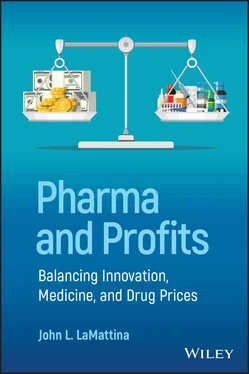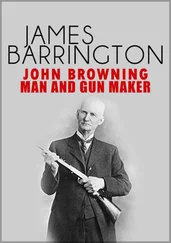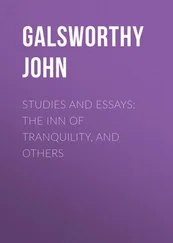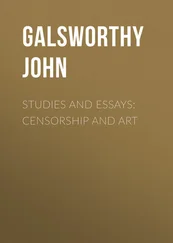John L. LaMattina - Pharma and Profits
Здесь есть возможность читать онлайн «John L. LaMattina - Pharma and Profits» — ознакомительный отрывок электронной книги совершенно бесплатно, а после прочтения отрывка купить полную версию. В некоторых случаях можно слушать аудио, скачать через торрент в формате fb2 и присутствует краткое содержание. Жанр: unrecognised, на английском языке. Описание произведения, (предисловие) а так же отзывы посетителей доступны на портале библиотеки ЛибКат.
- Название:Pharma and Profits
- Автор:
- Жанр:
- Год:неизвестен
- ISBN:нет данных
- Рейтинг книги:4 / 5. Голосов: 1
-
Избранное:Добавить в избранное
- Отзывы:
-
Ваша оценка:
- 80
- 1
- 2
- 3
- 4
- 5
Pharma and Profits: краткое содержание, описание и аннотация
Предлагаем к чтению аннотацию, описание, краткое содержание или предисловие (зависит от того, что написал сам автор книги «Pharma and Profits»). Если вы не нашли необходимую информацию о книге — напишите в комментариях, мы постараемся отыскать её.
Pharma and Profits — читать онлайн ознакомительный отрывок
Ниже представлен текст книги, разбитый по страницам. Система сохранения места последней прочитанной страницы, позволяет с удобством читать онлайн бесплатно книгу «Pharma and Profits», без необходимости каждый раз заново искать на чём Вы остановились. Поставьте закладку, и сможете в любой момент перейти на страницу, на которой закончили чтение.
Интервал:
Закладка:
Older treatments were modestly effective. Cure rates ranged from 40 to 80%, depending on the severity of the disease. Patients were given a cocktail of drugs plus injections of interferon for 24–48 weeks. However, these medicines are poorly tolerated, particularly the interferon component that causes flu‐like symptoms in patients. As a result, many with hepatitis C often avoided treatment.
Sovaldi TMprovided new hope. The pill was found to cure hepatitis C in more than 90% of patients in just 12 weeks. Furthermore, it is safer and roughly 20% cheaper than the older treatments that cost over $100 000. One would think that the maker of such a wonder drug would be hailed for providing a major medical advance. Instead, Gilead was vilified.
At a Financial Times U.S. Healthcare and Life Sciences Conference in New York City, I had a chance to hear Ms. Ignagni talk about the high cost of Sovaldi TM. During the Q&A session, I asked her the following question.
“Sovaldi TMis a drug that cures hepatitis C. It actually saves the healthcare system money in that it will prevent patients from dying from liver cancer, cirrhosis and liver failure. Liver transplants alone can cost $300,000 and then patients must take anti‐rejection drugs that cost $40,000 per year for the rest of their lives. The price of Sovaldi TM, while high now, will drop, first when competitive drugs in late‐stage development reach the market and then when the drug is generic. Given all of this, what price for Sovaldi TMwould have been acceptable to you – $60,000, $40,000, $10,000? What price are you willing to pay for innovation?”
Ignagni never answered the price question. Instead, she focused on the innovation part, saying that, for years, she has heard that high pricing is needed to sustain innovation. Yet innovation is still occurring. Her response ignores worrying trends that roil the biopharmaceutical industry – the mergers, the small company closings, the reductions in private investment in drug research and development (R&D). Yes, innovation is still occurring, but lower revenues result in less money invested in R&D. Less R&D equals less innovation.
Given the $1000 pill headlines, it was not surprising to see politicians jumping on the bandwagon and expressing outrage over the price. Rather than reacting to this medical breakthrough with applause, this furor sparked Senators Wyden and Grassley to probe all of Gilead’s expenses, from the acquisition of Pharmasset (originator of Sovaldi TM) to the costs of the development program. Their aim: to embarrass Gilead publicly and, perhaps, shame them into a price cut.
These senators and other politicians have little grasp of the intricacies of drug R&D. Sure, they know R&D is difficult and expensive. They might even appreciate that the entire process, from coming up with the initial idea to getting the US Food and Drug Administration (FDA) approval, can take 15 years. But they have little idea as to how and why drug prices are determined. Do patients or physicians really care how much a company spent in the discovery and development of a new medicine? What they want to know is whether the drug works and, relatively speaking, is it safe? The same can be said of payers. Again, they could not care less about R&D expenditures. They are much more concerned about the drug’s short‐term impact on their balance sheet.
Biopharmaceutical companies try to elicit sympathy by talking about failure rates. The industry works on the cutting edge of medical science, looking for novel compounds to prove or disprove medical hypotheses. This is difficult and often frustrating work. Far more projects fail than succeed. Thus, in justifying the high cost of new drugs, companies will cite figures showing that billions of dollars need to be invested across a portfolio of programs to get one new drug approved. Indeed, for a biopharmaceutical company to survive, it has to be profitable. It must provide a return on investment for its shareholders. However, patients, physicians, and payers do not shed tears over a company’s litany of failures. The belief is that companies should be rewarded for success, and not for “nice tries.”
Thus, in the minds of patients, physicians, and payers, the pricing of drugs should have little to do with the expense of biomedical R&D, nor should it be associated with recouping R&D investment. Pricing should be based on only one thing – the value that the drug brings to healthcare in terms of:
1 Saving lives.
2 Mitigating pain/suffering and improving the quality of life for patients.
3 Reducing overall healthcare costs.
OK, if one were to take that position, how do new, expensive medicines stack up in terms of delivering value? Are they worth the prices sought by drug companies?
In the case of Sovaldi TM, we have a drug that cures hepatitis C and, in doing so, prevents the downstream consequences of patients contracting liver cancer or needing a liver transplant. Rather than questioning Gilead’s management on the R&D costs generated in Sovaldi’s TMdevelopment, Senators Wyden and Grassley should ask the following questions:
1 How does this compound compare with existing hepatitis C treatments in terms of efficacy and safety?
2 How expensive are these other treatments?
3 Without this drug, how many patients with hepatitis C will die?
4 How many patients with hepatitis C will contact liver cancer or will need a liver transplant if their disease remains uncured?
5 Without SovaldiTM, what would be the ultimate cost to the healthcare system to treat the resulting cases of liver cancer and liver transplantations?
If these senators do this, they will find that even at $84 000 per patient, Sovaldi TMis well worth the expense. Its value is neither the R&D costs incurred in its discovery and development nor in the years or time and money invested at exploring other approaches to hepatitis C cures that did not work. Its value comes from saving lives and ultimately saving the healthcare system millions. When it comes to drug pricing, to paraphrase a former President Clinton’s advisor, James Carville: “It’s the value , stupid!”
To this point, the focus has been on Sovaldi’s TM$84 000 price, which is its list price . This number is often the starting point in negotiations with payers to gain access to their formularies and healthcare plans. In the period when only Sovaldi TMwas on the market, payers had a relatively weak hand. That, however, all changed when AbbVie launched its hepatitis drug, Viekira Pak TM. AbbVie’s list price was modestly lower at $83 319 for a course of treatment. However, now payers had a choice and competition can drive costs down. Big payers like Express Scripts and CVS Health do not pay the list price – the one usually quoted by the industry’s critics. Instead, given the vast number of patients in their plans, payers can negotiate significant reductions.
At a Forbes Healthcare Summit [2] shortly after AbbVie’s launch of Viekira Pak TM, the aforementioned Dr. Steven Miller, then the CMO of Express Scripts, could not hide his glee that Sovaldi TMnow had competition. In fact, he had selected Viekira Pak TMfor the 85 million members in the Express Scripts network. At the Forbes meeting he surprisingly announced that the price paid in the United States for hepatitis C drugs was less than in Europe. The Express Scripts number remains confidential. However, drug prices in Europe are public. At that time, the United Kingdom paid $55 000/patient for hepatitis C drugs and Germany $67 000. Given Dr. Miller’s comments, we can speculate that the US price for these drugs was under $50 000.
After the launches of Sovaldi TMand Viekira Pak TM, however, a new generation of hepatitis C drugs became available such as Harvoni TM(Gilead), Zepatier TM(Merck), and Mavyret TM(AbbVie). The last is particularly interesting. AbbVie’s list price for the drug, which is approved for all genotypes of hepatitis C, was $26 400 for an eight‐week treatment. If the infection was not cured after this time, another four weeks of treatment would cost an additional $13 200 (total of $39 600 for 12 weeks). Suddenly, curing hepatitis C had become relatively cheap.
Читать дальшеИнтервал:
Закладка:
Похожие книги на «Pharma and Profits»
Представляем Вашему вниманию похожие книги на «Pharma and Profits» списком для выбора. Мы отобрали схожую по названию и смыслу литературу в надежде предоставить читателям больше вариантов отыскать новые, интересные, ещё непрочитанные произведения.
Обсуждение, отзывы о книге «Pharma and Profits» и просто собственные мнения читателей. Оставьте ваши комментарии, напишите, что Вы думаете о произведении, его смысле или главных героях. Укажите что конкретно понравилось, а что нет, и почему Вы так считаете.












